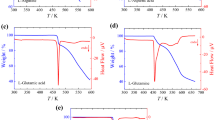Summary
It is known that L-glutamic acid molecules in crystals occur in chain- and ring-like spatial configurations. This paper shows that the chain-form is favored when the crystals are grown from saturated aqueous solutions at room temperature (25°), the ring-form at body temperature (37°), with the preliminary requirement that the saturated solutions have been maintained at their respective constant temperatures for at least 24 hours prior to crystalization. Under identical growth conditions, the molecules of D-glutamic acid and a second dicarboxyl amino acid, aspartic acid, show no such change in spatial configuration as a function of temperature.
Zusammenfassung
Bekanntlich kommt kristallisierte L-Glutaminsäure in ringförmiger und kettenförmiger Molekülstruktur vor. Die eine oder die andere Struktur wird erhalten, je nachdem ob die Kristallisation aus einer gesättigten wäßrigen Lösung bei 25° oder 37° C erfolgt. Während bei 25° die kettenförmige Struktur erhalten wird, tritt bei 37° die ringförmige Struktur auf, vorausgesetzt, daß die Lösung mindestens für 24 Stunden bei der entsprechenden Temperatur gehalten wird. Solche Unterschiede konnten bei der chemisch sehr ähnlichen Asparaginsäure nicht festgestellt werden.
Similar content being viewed by others
References
J. D. Bernal, Z. Kristallographie78, 363 (1931).
S. Hirokawa, Acta Cryst.8, 637 (1955).
A. N. Winchell, “Optical Properties of Organic Compounds”. Second Edition. New York: Academic Press. 1954.
R. C. Weast (ed.), Handbook of Chemistry and Physics, 49th Edition. Cleveland: Chemical Rubber Co. 1969.
E. W. Washburn (ed.), International Critical Tables, Crystallography. Vol. I. New York: McGraw-Hill. 1930. p. 325.
G. B. Goe, Ph. D. Thesis, University of Colorado, Boulder, Colorado. 1969.
N. E. Dorsey, “Properties of Ordinary Water-substance”. New York: Reinhold. 1940.
L. W. Tilton and J. K. Taylor, J. Res. National Bureau of Standards20, 419 (1938).
E. W. Washburn (ed.), International Critical Tables. Vol. VII. New York: McGraw-Hill. 1930. p. 13.
R. A. Horne, in: A. F. Scott (ed.), “Survey in Progress in Chemistry”.4, 1 (1968).
A. Lacourt and N. Delande, Mikrochim. Acta [Wien]1962, 48.
A. Lacourt and N. Delande, Mikrochim. Acta [Wien]1964, 547.
J. D. Bernal and R. H. Fowler, J. Chem. Phys.1, 515 (1933); L. Pauling, J. Amer. Chem. Society 57, 2680 (1935). Pauling uses the term “puckered” ring to describe his six-oxygen ring, but “chair” seems more common in recent literature; L. Pauling, „Die Natur der Chemischen Bindung“. Weinheim: Verlag Chemic. 1964. p. 432.
A. Dauvillier, “The Photo-Chemical Origin of Life”. New York: Academic Press. 1965. p. 107.
Author information
Authors and Affiliations
Rights and permissions
About this article
Cite this article
Goe, G. L-Glutamic acid crystals grown from saturated aqueous solutions at 25° and 37° c. Mikrochim Acta 66, 119–134 (1976). https://doi.org/10.1007/BF01257102
Received:
Issue Date:
DOI: https://doi.org/10.1007/BF01257102




